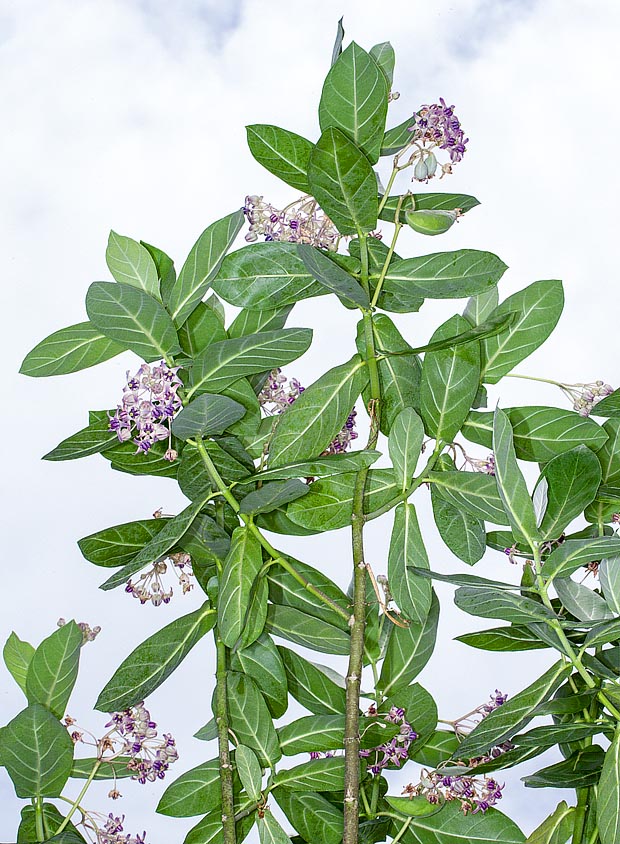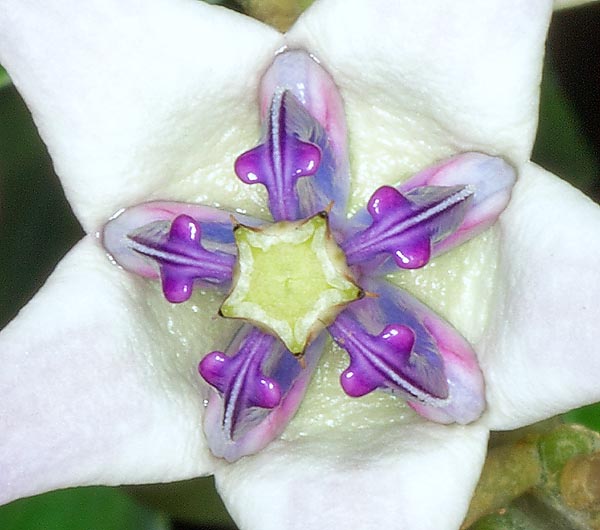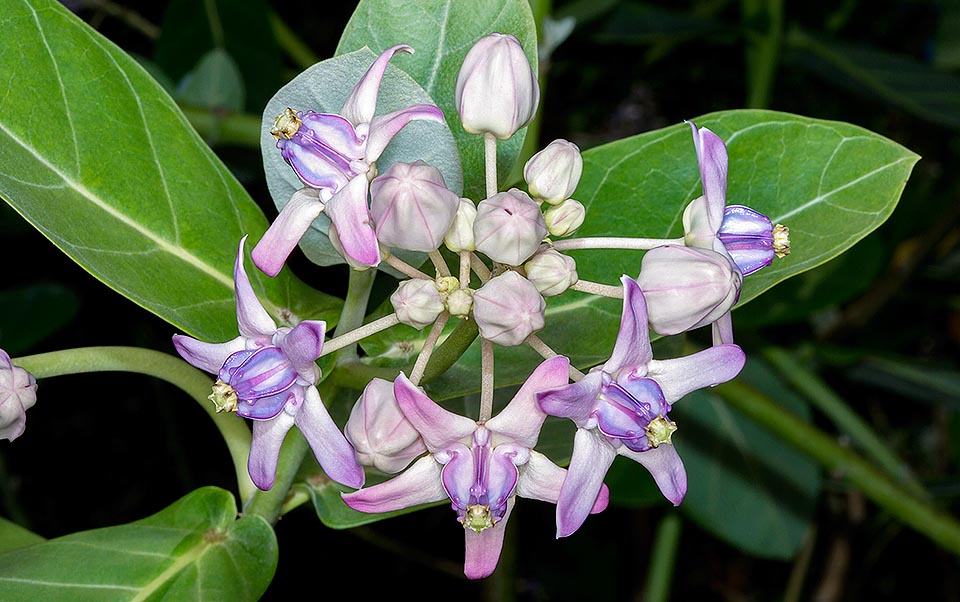Family : Apocynaceae

Text © Pietro Puccio

English translation by Mario Beltramini

Calotropis gigantea is an Asian species, tropical and subtropical, suitable also for warm temperate zones © Giuseppe Mazza
The name of the genus is the combination of the Greek adjective “καλός” (kalós) = beautiful and of the substantive “τρόπις” (trópis) = keel, with reference t the shape of segment of the staminal crown; the specific name is the Latin adjective “giganteus, a, um” = huge, with obvious reference.
Common names:crownflower, crownplant, giant milkwood, mudar (English); aushar, oschor (Arabic); akanda (Bengali); maioh, mayo,mayo-pin (Burmese); niu jiao gua (Chinese); arbre à soie, mudar (French); akam, madar, safedak (Hindi); belericu, erikka, yerriku (Malayalam); berduri, bidhuri, merigu, remigu, sidaguri (Malay); aank, akanda, madar (Nepali); arka, mandara (Sanskrit); lechoso (Spanish); arkku, badabadam, erukku, yercum (Tamil); Mudarpflanze (German); ekke, jilledu, mandaramu, nilledu, tellajilledu (Telugu); po thuean, paan thuean, rak (Thai); bong bong, coc may, nam ti ba (Vietnamese).
The Calotropis gigantea (L.) Dryand. (1811) is a shrub or a small evergreen tree, up to about 5 m tall, with erect greyish stems from whose wounds exudes a milky sap.
The leaves are sub-sessile, simple, opposite, decussate, oblong-ovate to elliptic with cordate base, pointed apex and entire margin, 6-25 cm long and 3-12 cm broad, coriaceous, pale green above, whitish green below, due to the presence of a fine down, and with prominent veins.
The inflorescences, on a robust, 5-16 cm long, peduncle, are axillar umbelliform cymes bearing numerous flowers, on a 2-5 cm long tomentose pedicel, white to pale lilac to purple, fleshy, of 2,5-4 cm of diameter. Five lobes calyx of 1,5 cm of diameter, corolla with 5 ovate lobes, 1-1,5 cm long and 0,5-1 cm broad, usually retroflexed, crown with 5 fleshy segments, keel shaped, 0,6-1 cm long. The fruits are ellipsoid follicles in pair, curved, 5-10 cm long and of 2,5-5 cm of diameter, containing several ovate, flat seeds, about 0,6 cm long and 0,4 cm broad, equipped at one end with a tuft of silky hairs, 2-4 cm long, that favour their dispersion through the wind.
It propagates by seed directly in the ground, where the climate allows it, or in containers enough high to allow the taproot to freely develop and to no be damaged during the transplant.

The elegant staminal crown with the pistil, seen from above, surely deserves the name of " kalós ", beautiful in Greek, to the root of Calotropis, the scientific name given to this genus © Giuseppe Mazza
Fast growing species that needs very few cares, requires full sun and vegetates on any kind of soil, provided perfectly draining, also in degraded semi-desert areas unsuitable for any other cultivation; resists to long drought periods, to the wind, the high temperatures and the marine sprays.
It is often utilized, due to the almost continuous blooming, as isolated specimen or for edges, in the tropical, subtropical and marginally in the temperate-warm climate zones, where can resist to lowest values of temperature, exceptional and short lasting, of about -2 °C.
The sap was in the past utilized in the tanning of leather and for getting a yellow colouring, whilst from the branches they get a thin, very resistant, white fibre for ropes, fishing nets and fabrics even if nowadays of marginal use. The plant plays also an important rôle in the reproduction of some butterflies that lay the eggs on the leaves that are the food for their larvae.
All parts of the plant contain highly toxic substances, among which cardioactive glycosides, such as the calotropin, a rapid action cardiac stimulant, 15-20 times more poisonous than the strychnine.
The contact of the sap with the eyes causes serious irritations up to temporary blindness and dermatitis with the skin, whilst the ingestion causes increasing effects, depending on the quantity, in the mouth and in the digestive system, up to death, even if it an involuntary ingestion in lethal quantity is quite difficult to occur due to the particularly bitter taste.

It’s a fast growing poisonous shrub that reaches the 5 m of height. Continuous blooming and active principles screened by the official pharmacopoeia © G. Mazza
Since remote times various parts of the plant are utilized in the traditional medicine for various pathologies. Laboratory researches have evidenced the presence of numerous bioactive compounds, amongst which alkaloids, flavonoids, cardioactive glycosides, steroids and terpenoids, but at the moment (2016) the studies on their therapeutic effects are still inadequate and for most of the traditional uses a clinical validation has not been done. The plant is surely a source of compounds of potential interest for the official pharmacopoeia, but needs further laboratory studies and clinical validations on the single constituents.
The flowers, long lasting, are utilized in the floral arrangements and in the Hawaii for the classic welcome garlands (leis).
Synonyms: Asclepias gigantea L. (1753); Periploca cochinchinensis Lour. (1790); Calotropis gigantea (L.) R. Br. ex Schult. (1820); Streptocaulon cochinchinense (Lour.) G. Don (1837); Madorius giganteus (L.) Kuntze (1891).
→ To appreciate the biodiversity within the APOCYNACEAE family please click here.
